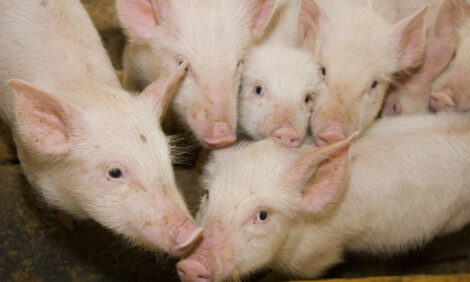



Proposed Updates to Canada's Health of Animals Act Expected Within Months
CANADA - Farm-Scape: Episode 2272. Farm-Scape is a Wonderworks Canada production and is distributed courtesy of Manitoba Pork Council and Sask Pork.Farm-Scape, Episode 2272
Sometime within the coming months, the Canadian Food Inspection Agency (CFIA) expects to publish the official draft of a revised Health of Animals Act.
Part 12 of the Health of Animals Regulation addresses the transportation of all species of livestock into Canada, out of Canada, and within Canada by any mode of transport, air, land or water. When introduced in 1975, the intent was to prohibit poor practices and reduce the risk of injury, suffering or death of animals in transit.
Last December, CFIA released a document, through its website at [http://www.inspection.gc.ca/english/anima/heasan/transport/notavie.shtml], which outlined several changes being considered to regulations that deal with the transportation of livestock. It also posed several questions and encouraged stakeholders to offer comments and suggestions during what is described as a pre-consultation period.
Over 100 Submissions Received
"We have received comments from a little over 100 individuals or organizations," states Dr. Gord Doonan, the Canadian Food Inspection Agency’s senior staff veterinarian responsible for humane transportation of animals. "These represent a wide range of interests from industry, through researchers, transporters to the general public and also animal welfare and animal protection organizations. We've also received comments at meetings that we've attended across the country on invitation to explain what we're thinking about doing."
Dr. Doonan stresses that this is only informal. The formal consultations have not begun and will take place after publication in Canada Gazette 1.
”Because of the large number of amendments that we’re considering, we're involving the stakeholders much earlier in the process,” he notes.
Proposed Changes Intended to Update and Clarify Regulations
Dr. Doonan stresses that the types of changes are mainly a clarification so there are some areas in the regulations that are vague and they require either definition or removal of terms that are vague such as adequate or likely to. The other part of it is to update the content of the regulations, to bring them into alignment with current knowledge and with the types of transportation that are happening today and also with increasing public expectations for the welfare of animals.
Saskatchewan Pork Development Board (Sask Pork) Producer Services Manager Harvey Wagner says there is not going to be a lot of change. For the hog industry in general, it brings the legislation more in line with current practice.
"The regulators are interested in making sure current practices are in line with current understandings,” says Wagner. “The last time those regulations were adjusted was a long time ago and most of the animals, at that time, moved by rail and by ship. Now almost no animals move by rail or ship. They're mostly moving by truck."
Among the groups to formally make a submission was the Pig Welfare Group, a committee operated through Manitoba Pork Council and made up of provincial animal welfare organizations, veterinarians, researchers and private companies. Pig Welfare Group Chairman Ray Timmerman notes the committee presented a fairly detailed brief.
"We got some of the trucking firms involved to come up with some of the research that they've done and, along with some that we've done hopefully this will be considered by CFIA when they come out with their final draft of the recommendation," he says.
Border Waits Identified as Animal Welfare Concern
One of the group's key recommendations outlines concerns related to long waits at the Canada U.S. border.
Timmerman notes, "We've been noticing delays at the Canada US border and we're kind of concerned [with this] as being a welfare issue and we're asking CFIA to make a designated livestock lane through Canadian customs."
Timmerman says these trucks are followed right in line with all the other commercial trucks and sometimes they're being held up an hour to two hours before they're able to clear customs.
“We strongly feel this is an animal welfare issue and what we'd like to see is a designated lane so that these trucks are pulled out of the line and are in a separate line and can clear through customs a lot sooner,” he says. “This seems to be one of the concerns that a lot of the producers have and also the truckers that move pigs across the border."
Trucker Quality Assurance Training Recommended
The Pig Welfare Group's submission also calls for mandatory training of trucker involved in the transport of livestock.
"What we're really interested in having is all truckers take Trucker Quality Assurance (TQA) where they have training as to what is all needed in the movement of pigs,” says Timmerman. “We [Manitoba Pork Council] offer them and other provinces have as well."
He adds, "They have it down across the line already and what's happened is there's a lot of packing houses requesting this course otherwise they [truckers] may not be able to unload."
Another group that presented a submission was Alberta Farm Animal Care (AFAC), a coalition of provincial commodity, veterinary medical, university and government organizations.
"We're all about improving animal welfare and doing that from an industry perspective," explains AFAC Chairman David Hyink. "We're really trying to facilitate a discussion between CFIA and industry and have some changes that are meaningful and reflect the good practices that are happening in industry already."
AFAC Suggests Referencing Codes of Practice
Among AFAC's key recommendations is a request to have the legislation make reference to the latest scientific research.
"Industry has really started to look at their codes of practice right now,” says Hynink. “I know that, at a national level, there's a new National Farm Animal Care Council which has been given the job of restarting the development of the code of practice and the renewing of the code of practice program.”
He says one of the big things industry is asking for is that, as these codes of practice change and as they're updated with the newest science and the newest information that we have, if the regulations could refer to the codes of practice in industry. Then they'd be much more current and they'd reflect the science and the technological changes that are happening in industry.
Research Leads to Improved Understanding
"I think really in the last 20 years we've been able to understand a little better what the impact of things like heat and cold are on animals and then also of crowding and how they interrelate,” says Wagner. “So when we see high temperatures with high humidities, we know that we have to reduce the amount of animals in there. You can just track that by doing the statistics, what's the death loss given these temperatures and what happens during that time so, that area has been fairly well addressed."
He stresses, "We've lowered death rates in transport by a factor of two or three over the past two decades. We just don't see a lot of animals dying in transport and it's mostly just because of understanding what causes the problem, some changes in the equipment, some changes in the approach. The handling of the animals is really important on the farm during loading and then in the transport and if people pay attention to the specific critical points, like give the animals time and don't crowd them and things like that they'll respond well."
Hyink says that right now there is a lot of effort and some research money that's being directed, even this year, towards getting a better understanding of what actually is happening on the road and so there's some bench marking studies being proposed.
"Through these studies, we're hoping to get a better idea of what actually is happening on the road,” he says. “A lot of what we have so far is anecdotal and to get some real facts and information would give us a much better picture of what actually is happening, where the problems areas in transportation might be and what the needs are."
For Farmscape.Ca, I'm Bruce Cochrane.








